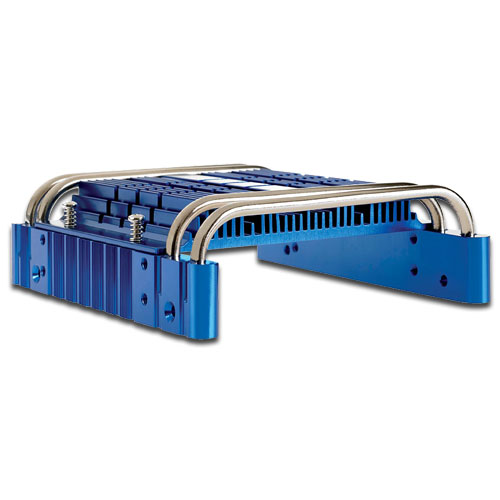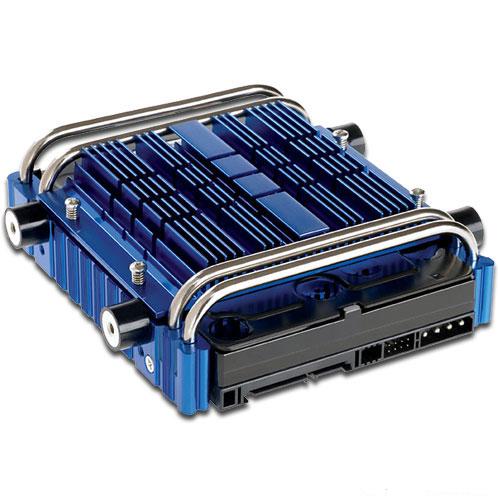Specifications
The ULT40010 is a passive 3.5" hard drive cooler. The unit is an attractive blue aluminum, bristling with cooling fins along the top of the cooler itself. Heat pipes run along the front and rear of the unit, providing an additional boost in thermal transfer capability. Four rubber spacers screw into the unit and act as mounting points for the chassis screws. Ultra has chosen to include a grounding wire with the ULT40010, which is a sensible precaution given that the aforementioned spacers are the primary contact point with the case.

Installation of the ULT40010 is simple, aided by an eight-step illustration supplied in the packaging. The hard drive mounts underneath the cooler, with the top of the drive flush against the cooler's heat transfer plate. Screws pass through the cooler and into the standard mounting holes on the sides of the hard drive. The four rubber dampers screw into the cooler's side, in either an upper or a lower position, to accommodate the style of case that will house the cooler. There are four spring-loaded screws on the top of the ULT40010 that ensure that the cooler's heat transfer plate is firmly pushed up against the top of the hard drive casing; this will ensure maximum surface area contact and thus heat dissipation. The cooler does not use thermal paste, so this is an important consideration.

The Ultra cooler installs into a free 5.25" bay in a standard PC case. While removing the front panel isn't necessary, we found it substantially easier to install the assembled cooler from the front of the case, rather than trying to insert it from inside the case cavity. Once the cooler is in place, screws go through the PC case's mounting holes and into a screw hole in the center of the rubber dampers. This results in only rubber mounts touching the PC case, and this helps to lessen drive vibration compared to a standard metal-on-metal mount configuration. Attaching the included grounding strap to a drive mount hole on the PC case completes the installation process.
| Ultra ULT40010 Hard Drive Cooler | |
| Heatpipe Material | Sintered Powder Heatpipe |
| Heatsink Material | Aluminum |
| Grounding | Wire Grounding |
| Dimensions | 143 x 122 x 42mm |
| Weight | 402g |
| . | |
The ULT40010 is a passive 3.5" hard drive cooler. The unit is an attractive blue aluminum, bristling with cooling fins along the top of the cooler itself. Heat pipes run along the front and rear of the unit, providing an additional boost in thermal transfer capability. Four rubber spacers screw into the unit and act as mounting points for the chassis screws. Ultra has chosen to include a grounding wire with the ULT40010, which is a sensible precaution given that the aforementioned spacers are the primary contact point with the case.

Installation of the ULT40010 is simple, aided by an eight-step illustration supplied in the packaging. The hard drive mounts underneath the cooler, with the top of the drive flush against the cooler's heat transfer plate. Screws pass through the cooler and into the standard mounting holes on the sides of the hard drive. The four rubber dampers screw into the cooler's side, in either an upper or a lower position, to accommodate the style of case that will house the cooler. There are four spring-loaded screws on the top of the ULT40010 that ensure that the cooler's heat transfer plate is firmly pushed up against the top of the hard drive casing; this will ensure maximum surface area contact and thus heat dissipation. The cooler does not use thermal paste, so this is an important consideration.

The Ultra cooler installs into a free 5.25" bay in a standard PC case. While removing the front panel isn't necessary, we found it substantially easier to install the assembled cooler from the front of the case, rather than trying to insert it from inside the case cavity. Once the cooler is in place, screws go through the PC case's mounting holes and into a screw hole in the center of the rubber dampers. This results in only rubber mounts touching the PC case, and this helps to lessen drive vibration compared to a standard metal-on-metal mount configuration. Attaching the included grounding strap to a drive mount hole on the PC case completes the installation process.










31 Comments
View All Comments
Ajax9000 - Monday, November 5, 2007 - link
So you take a 3.5" drive out of a 3.5" bay, wrap it in a metal shroud, stick it in a 5.25" bay and its temperature goes down ...Well, how much would the teperature have gone down if you just mounted the bare drive in the 5.25" bay?????????????
SunAngel - Sunday, November 4, 2007 - link
The following comments are not directed towards the article itself, but the product.It amazes me with all the "hotroding" going on in computers. A hard drive cooler? Come on, get real. If your hard drive is running hot I think you have more serious problems than a hard drive cooler will solve. Like maybe you need to have better case cooling. But, I guess there are individuals out there that will fall for this type of product.
At $43 MSRP, this should put this product in the grave real quick. For $43 you could purchase a better cooling case or upgrade the cooling the case you already have. I feel so ashamed when I read reviews of these types of products. I always think, "Damn, if this persons wasn't so immature they would see this product is worthless." I don't know why I feel ashamed, hell, its not my money. It as if a bully is taking money from a baby. I just want to bash the nose to back of their skull. Yet, I know we are different and have different needs and tastes.
So I'm going to end my jibber jabbing and let bygons be bygons.
mechBgon - Sunday, November 4, 2007 - link
Not to be a language Nazi, but with reference to the title, the phrase is "put it through the wringer," from the olden days when that was part of doing laundry. :)mindless1 - Sunday, November 4, 2007 - link
So we have heatpipes or at least heatpipe looking *things*, but what's missing? The heatpipes should be connected to fins to increase their surface area, that is essentially the point of heatpipes. Having that fin plate arrangement on top is far less effective than it ought to be.For this reason I'd have to consider the product misengineered, before even considering that if it were well engineered it would still make minimal difference unless the drive was installed in some hot cramped place where it shouldn't have been w/o another cooling method already like passive intake holes in front of the bay or a fan. A couple degrees isn't even worth the time to install this if they gave it to you for free.
If it had LEDs and the heatsink was giganormous enough that you had to buy another case with it's own zip code just to use it, then it would at least impress the younger crowd. This product has free after rebate written all over it.
RichUK - Sunday, November 4, 2007 - link
What a useless bit of kit. This is akin to putting spinners on your pimped out Hummer.jmv - Saturday, November 3, 2007 - link
What does a "7% decreased load temperature" mean?Is that 7% with respect to
a) ambient room temperature
b) ambient case temperature
c) 0 C
d) 0 Fahrenheit
d) absolute zero (-273 C)
I suspect it's c), but that would be a completely arbitrary scale. For example, the result would be different if measured in Fahrenheit!
Dave Robinet - Saturday, November 3, 2007 - link
7% drop versus what the drive originally ran at (ie. without the cooler).SO:
Without the heatsink, the Raptor was 58.6 degrees. With the heatsink, it was 54.7. That difference (3.9 degrees) is roughly 7% of the original 58.6 degree temperature (actually 6.665%).
Sorry if that wasn't clear. Thanks for reading, and for the smile this morning. :)
dnd728 - Saturday, November 3, 2007 - link
Hmm... You shouldn't really do this. It would only mean anything if you use the ambient temperature as your base. 0C is simply an arbitrary point chosen because that's when water freezes. It has no relevance here - it means nothing.Woodchuck2000 - Saturday, November 3, 2007 - link
Spot on... Seriously, before you write an article about practical thermodynamics, take a few seconds to actually do some research. The only meaningful reading you can take here is the difference beween drive and ambient temperature. You don't actually specify how you measure the drive temperature, and you don't consider the effects of the different mounting mechanisms within the case - the default 4 in 3 hard drive mounting of the Stacker 830 will be lousy for convective cooling compared with the 5.25" bay mounts which have clear air above and below (unless you've mounted between your two optical drives - again, not stated). This is, in the end, a pointless product which makes no practical difference to your rig and I would expect a site of Anandtech's calibre to actually say so.puffpio - Friday, November 2, 2007 - link
any thermal paste used?Totally passive system would be sweeeeeeeet